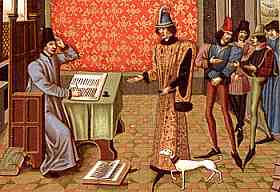



If you are looking at this page without frames, there is more information about medieval writing to be found by going to the home page (framed) or the site map (no frames).
| The Concept of Text in the Manuscript Tradition (4) | |||
| In some cases individual writers produced diferent versions of their own work. This tradition goes back as far as St Jerome, with his various translations of the Psalms. A well known example from later medieval times is William Langland's allegorical poem Piers the Ploughman. This exists in three main variants, all of which were copied on and survived in multiple manuscripts. Perhaps, in some ways, this example is like three editions of a printed book, except that succeeding editions are not regarded as necessarily superseding, or rather obliterating, the previous ones. | |||
 |
|||
| Jean Froissart, chronicler of the Hundred Years war between England and France, produced several different versions of his chronicles. As a lay writer dependent upon patronage, and with patrons on both sides of the conflict, he seems to have felt the need to periodically amend the record. |  |
||
| Froissart writing, after a Burgundian manuscript of around 1460 (Bibliothèque de l'Arsenal, ms 5190). Given the context, I couldn't resist putting this in. | |||
| Where autograph copies of an author's work survive, there may be a more interesting problem. Authors were known to rework their words on the parchment, inserting addenda into the margins and between the lines, erasing, correcting and commentating on their own work. The next copyist of the work makes an editorial decision about what goes in and what is left out, but if the original survives, it becomes a more complex text. This type of manuscript survives, for example, for the various works including the chronicles of Matthew Paris, 13th century monk of St Albans. | |||
 |
Segment from the mid 13th century Historia Anglicorum of Matthew Paris (British Library, Royal 14 C VII), by permission of the British Library. | ||
| The example above shows a large marginal addition and some brief notes. The good monk had some extravagant views and also attempted, before his death, to erase or paste over some of his more inflammatory passages, but a complete copy had already been made. The text of the manuscript is not a definitive single work, but a series of thought processes over time. Petrucci (Petrucci 1995) has made some interesting comments on the autograph manuscript book in an Italian context, and drawn parallels between such works and the notary's minute, or draft from which the final document is derived. In his words, the annotated and corrected author's book is not so much a text as an archive. Chronicles are particularly susceptible to this treatment, as they document contemporary events, which may need some amending in retrospect, and they were not created generally for multiple copying, but as a single record for a particular establishment. | |||
| The advent of the printing press made books steadily more available to a larger proportion of the population, but they were all reading exactly the same text. Even works like the book of hours were less able to be customised when they were put out as printed works in the 16th century, although presumably more people could own one. Mechanical reproduction leads to a different concept of what a text should be, with accuracy and authenticity as primary attributes. Concepts like copyright and plagiarism only have validity in this era of mechanical reproduction. Medieval authors were not cavalier about attribution, and used it extensively, but the intellectual commons were a larger and more fertile field. |  |
||
| A leaf from a book of hours printed in Paris in the early 16th century, from a private collection. | |||
| Periodically, when I want to annoy people, I claim that the internet, and specifically the World Wide Web, is more like a medieval manuscript than a printed book. This applies to the way we use graphical elements to increase the comprehensibility of text, the way our page layout is constrained by common sense and legibility but not technological determinism or editorial overlordship, and because we don't always design it for sequential reading from beginning to end. Another similarity is in the way text can become organic. Go to The Internet Archive and see how Medieval Writing has changed over the years. Like Jean Froissart or Matthew Paris, I have added, amended and corrected, and this is not hidden from you. Is the reason that conventional publishers are being very slow to abandon their current methodologies because of their capital investment in existing technologies, or because they can't bear the thought of text escaping from its industrial boundaries back into the medieval wilds? | |||
| |
|||
If you are looking at this page without frames, there is more information about medieval writing to be found by going to the home page (framed) or the site map (no frames). |
|||